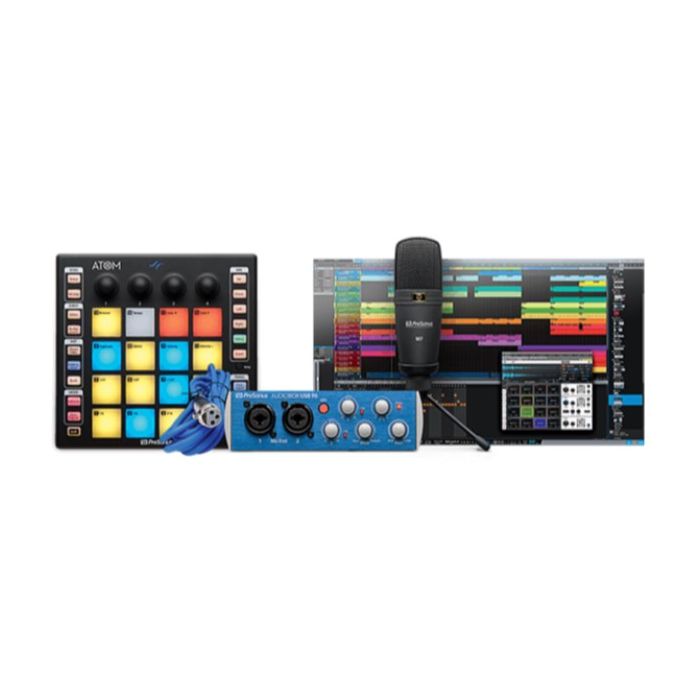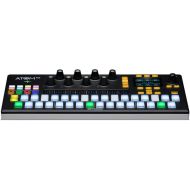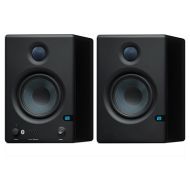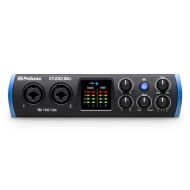PreSonus ATOM Producer Lab
ATOM Producer Lab: Complete Production Kit
ATOM Producer Lab
Features
Overview
- Complete, all-in-one music production kit
- ATOM™ USB pad controller for making beats, playing virtual instruments, and triggering samples and loops
- AudioBox USB® 96 audio/MIDI interface
- Studio One® Artist and Ableton® Live Lite production software and Studio Magic Plug-in Suite
- M7 studio condenser microphone
- MVP Loops content custom-curated for ATOM
- Trigger loops and effects and play virtual instruments with 16 full-size, velocity- and pressure-sensitive RGB pads.
- 8 assignable pad banks
- MIDI Keyboard mode, Note Repeat mode, and Full Velocity mode to customize instrument control. (Application dependent)
- 4 programmable rotary encoders and 20 assignable buttons, navigate and set more parameters faster
- Pressure switchable between MIDI aftertouch, channel pressure, and CC messages
- Selectable pad velocity curves and pad pressure thresholds
- AudioBox USB 96 audio interface and ATOM pad controller are automatically detected by Studio One Artist, no setup required
- Elegant single-window work environment
- Powerful drag-and-drop functionality
- Unlimited audio tracks, MIDI tracks, virtual instruments, buses, and FX channels
- Navigate and choose an instrument from the Browser
- Studio One dynamically switches ATOM between Keyboard and Drum modes depending on the selected instrument
- 31 Native Effects and 5 virtual instrument plug-ins
- 10+ GB of third-party software, loops, and instruments
- Mac- and Windows-compatible
- Navigate Up, Down, Left, or Right in Live's Session view in banks of 4 with ATOM's navigation buttons
- Launch clips and scenes using ATOM's Session mode
- RGB LEDs display which clips are playing or stopped and reflect each clip's assigned color
- Play virtual instruments and Live's Drum Rack device using ATOM's Note mode
- Navigate Live's mixer using ATOM's Channel mode
- Select, Solo, and Record Enable channels as well as stop all clips on a selected channel
- Knobs are used to change track volume, track panning, Sends A, and Sends B for the selected bank
- Switch between Session and Arranger views from ATOM
- Record in either Session Record or Arranger Record modes
- Dedicated User mode for custom user assignments, Metronome On/Off, Save and Undo, Loop On/Off, and more...
- Mac- and Windows-compatible
- Bus-powered USB 2.0 audio and MIDI interface
- 2 combo mic/instrument inputs with Class A mic preamplifiers
- 48V phantom power (for included M7 microphone or other condenser microphones)
- Zero-latency monitoring via internal analog mixer
- Headphone jack with level control
- Compact, rugged, all-metal chassis
- USB cable included for connection to computer
M7 Microphone
- Large-diaphragm design
- Captures far more detail than a dynamic mic
- Phantom-powered via AudioBox 96 USB
- 9' / 3 m cable included
- Mic stand adapter
- Cloth carry bag included
Computer system requirements:
Below are the minimum computer-system requirements for ATOM with Studio One 4 or later:
Mac
- Mac® OS X 10.11 or higher (64-bit only)
- Intel® Core® 2 Duo processor (Intel Core i3 or better recommended)
Windows
- Windows® 7 (SP1 + platform update), Windows 8.1, or Windows 10 (64-bit only)
- Intel Core Duo or AMD® Athlon™ X2 processor (Intel Core 2 Duo or AMD Athlon X4 or better recommended)
Mac and Windows Systems
- 4 GB RAM (8 GB or more recommended)
- USB 2.0 port
- Internet connection (needed for software installation and activation)
- Monitor with 1366 x 768 resolution (high-dpi monitor recommended)
- 40 GB hard-drive space
- Universal Control 2.9 or later (for firmware updates)
- Studio One 4.1+ required for native integration
ATOM Technical Specifications
Input
Connection Type: USB 2.0 (bus-powered)
Pads, Buttons, and Knobs:
- 16 full-size velocity- and pressure-sensitive, RGB LED pads
- 20 assignable buttons
- 4 endless rotary knobs
- 1 Setup button
Dimensions
Height: 0.82” (20.75 mm)
Depth: 7.68” (195 mm)
Width: 7.95” (202 mm)
Weight: 1 lb. (0.45 kg)
AudioBox USB 96 Technical Specifications
Microphone Preamp
Type: XLR Female Balanced
Frequency Response (±3.0 dB): 20 Hz to 20 kHz
Input Impedance (Balanced): 1200Ω
THD+N (unwtd, 1 kHz @ +4 dBu Output, Unity Gain): < 0.008%
S/N Ratio (Unity Gain, Ref. = +4 dBu, 20 Hz to 22 kHz): > 95 dB
Common Mode Rejection Ratio (1 kHz, 55 dB Gain): > 45 dB
Gain Control Range (± 1 dB): 0 dB to 35 dB
Max Input Level (Unity Gain, 1 kHz @ 0.5% THD+N): -3 dBu
Phantom Power (±2 VDC): +48 VDC
Instrument Input
Type: ¼" TS Female Unbalanced
Input Impedance: 0.5 MΩ
Line Outputs
Type: ¼" Balanced
Output Impedance: 51Ω
Headphone Output
Type: ¼" TRS Active Stereo
Maximum Output: 60 mW/Ch @ 60Ω Load
Frequency Response: (±1.0 dB) 20 Hz - 30 kHz
MIDI I/O
Type Dual: 5-pin Female DIN
Digital Audio
ADC Dynamic Range (A-wtd, 48 kHz Sample Rate): 105 dB
DAC Dynamic Range (A-wtd, 48 kHz Sample Rate): 105 dB
Bit Depth: 24
Reference Level for 0 dBFS: +4 dBu
Internal Sample Frequency Selections (kHz): 44.1, 48, 88.2, 96
Power: USB 2.0 bus-powered
Physical
Dimensions: 1/3U (steel chassis)
Height: 5.5” (139.7 mm)
Depth: 1.75" (44.45 mm)
Width: 5.5” (139.7 mm)
Weight: 5 lbs (2.27 kg)
M7 Microphone Specifications
General
Type: Large-diaphragm condenser microphone
Element: Electret
Polar Pattern: Cardioid
Frequency Response: 40 Hz - 18 kHz
Sensitivity: -39 dBV/pa (12.2 mV/pa)
Rated Impedance: 200Ω
Equivalent Input Noise (EIN): 20 dB
Maximum SPL: 136 dB SPL
Phantom Power Required: +12 to +52 VDC, 3 mA
S/N Ratio: 74 dB
Dynamic Range: 11 dB
Current Consumption: 3.5 mA
Physical
Diameter: 2.13" (54 mm), maximum
Length: 6.69" (170 mm)
Weight: 11.3 oz. (320g)





